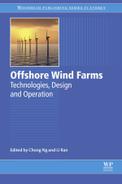Developments in materials for offshore wind turbine blades
Abstract
Rotor blades are large-scale integral hybrid structures. For a large part they are made of composites, with bolted blade–hub connections and integrated lightning protection, and including various types of composite structural materials and elements. During their life in an offshore wind farm they suffer from environmental loads, extreme loads and fatigue.
This chapter discusses the role of materials in creating structures capable of dealing with these loads and highlights current and future developments in (composite) materials, manufacturing methods and design philosophy.
A case study is included, where a blade is designed using integrated wind turbine design software, further exemplifying the relationship between the main design drivers, material choice and structural freedom.
Keywords
Fatigue; Loads; Manufacturing; Materials; Rotor blades; Simulation; Testing5.1. Key requirements for blade materials
5.1.1. Loads on rotor blades
5.1.2. Structural elements of rotor blades

5.1.2.1. Requirements for materials
In manufacturing

Specific properties
Cost
5.2. Role of testing materials and structures in the blade design process
5.3. Case study on material selection and blade design

![]()
![]()
5.4. Future trends
5.4.1. Material and structural damping
5.4.2. Multi-axial testing and damage progression
5.4.3. Micromechanical modelling and interaction with condition monitoring
5.4.4. Coatings, erosion protection
5.4.5. Design philosophies – safe life or damage tolerance?
5.4.5.1. Inspection, maintenance and repair
5.4.5.2. Role of condition monitoring
5.4.5.3. Life re-assessment and extension
Abbreviations and nomenclature
| R-ratio | Ratio of minimum to maximum cyclic value (valley-to-peak) in fatigue load |
| UD | Unidirectional (refers to fibre direction in composite laminates) |
| t (s) | Thickness distribution in spanwise direction |
| t′(s) | Thickness distribution transformed with shape function |
| j | Thickness distribution shape function |
| α1, α2 | Shape parameters in thickness distribution shape function |
| αh | Scale parameter in thickness distribution shape function |
| SHM | Structural Health Monitoring |
| Crimp | The tortuosity of a fibre or roving due to the weaving pattern |










